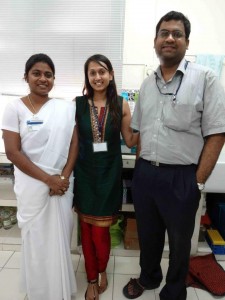
Girls dressed in salwar kameez at festival
It felt good to be back on Indian soil, the place where I first entered this world. The Indian air was thick and hot, cars and motorbikes honked in the background. As I exited the auto-rickshaw and entered the hospital, I noticed the enormous line of patients waiting to be seen in the diabetes clinic.
The women wore traditional sarees and salwar kameez (blousy trousers and tunics), the men dressed in pants and dhotis (draped cloth knotted around the waist). Most wore slippers, some were barefoot. All were diabetic. Good as it was to be “home”, I was disturbed by the thought that there are so many more people in the rural countryside without access to insulin or proper diabetic care.

The author (center) with Mercy Inbakumari and Ron Thomas, M.D., in the metabolic clamp room at CMC, Vellore
Although I grew up in the U.S., I was born in Chennai, about a 3-hour drive from the internationally renowned Christian Medical College (CMC) in Vellore where I’m working as part of my post-doctoral research fellowship with Einstein’s Global Diabetes Institute (GDI). As of 2011, the global prevalence of diabetes is currently estimated at 343 million. Projections are stark. The International Diabetes Foundation estimated by 2030, 100 million Indians will have diabetes.
I’ve always been aware of the long-term care needed to manage diabetes. My father was diagnosed with prediabetes when I was young. My grandmother, though she was thin all her life and is still well and alive in her 80s, has been a diabetic for over 40 years. Early on I came to learn that one of the genetic and environmental downfalls of my Indian heritage was the looming threat of diabetes. But not everyone had the same knowledge.
I met a particularly wonderful young woman during one of my clinics, who said hello to me in Tamil, her native language and mine as well. I envied her outfit, a colorful maroon and green salwar, with intricate stitching detail at the neckline. I learned quickly that she was a rather non-compliant type 1 diabetic.
Eager to understand why the young patient was not taking her insulin, the attending physician asked: “Why did you forget to take your insulin? Did you forget to put on your clothes before coming here?” she asked.
“No, I didn’t forget to do that,” the young woman answered shyly, looking at the floor.
“No, you didn’t, because I see you’re wearing a very nice salwar. So why did you forget your insulin? Taking insulin should be second nature to you,” the doctor continued. The young woman sat silently for a moment, and then offered an explanation in a muffled voice: “The power went out for a few hours like it does every evening, and I was tired after studying and fell asleep. I forgot my insulin completely.”
The doctor and nurse educator nodded in understanding, and proceeded to spend an hour teaching the young woman about her disease, explaining that her body doesn’t make insulin. They reminded her of the importance of compliance in terms of long-term health. The young woman shook their hands at the end of the appointment, clearly pleased to have people that cared about her health. She smiled and waved at me as she left the room, and I couldn’t help but smile back, pleased to be reminded of why I went into medicine to begin with.
Although she originally hadn’t understood the full impact of her decision on her health, the young woman appeared to finally understand the nature of her disease and how to control it. Perhaps, with continued education, we can send more patients back out into the world armed with the knowledge and resources to treat their condition and live better, healthier lives.


Comments on this entry are closed.
I enjoyed reading your article. You describe the BIG problem of diabetes in India with that example really well. I am a business student with an aim to tackle the problem of diabetes in India through an entrepreneurial venture.
I would be keen to hear your thoughts on the current infrastructure in India to manage population wide diabetes.